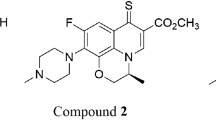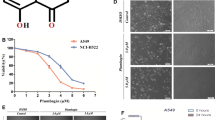Abstract
Arsenic trioxide (As2O3) is a potent anticancer drug for the treatment of acute promyelocytic leukemia. However, the clinical applications of the agent to treat solid tumors are largely compromised by the drug resistance. Our previous study demonstrated that resveratrol, a plant-derived natural product, could potentiate the toxicity of arsenite in lung adenocarcinoma A549 cells at relatively high concentration, indicating that combination of resveratrol and As2O3 may be a helpful strategy to solve the drug resistance of As2O3 in tumor cells. To test this possibility, in the present study, we determined the combined effects of resveratrol and As2O3 in cultured A549 cells. Our results showed that co-treatment of resveratrol with As2O3 resulted in a synergistic augmentation of cytotoxicity and apoptosis in cells at the tested concentration. To further reveal the detailed mechanism of this synergistic effect on cytotoxicity and apoptosis, apoptosis-related proteins, DNA and chromosomal damage, and the level of oxidative stress were also evaluated. Our data revealed that co-treatment with resveratrol and As2O3 caused more genotoxicity and serious oxidative stress in A549 cells than that of single agent treatment. Moreover, resveratrol and As2O3 could also corporately enhance the release of cytochrome c and the expressions of death receptor Fas and FasL. Together, our results suggest that resveratrol and As2O3 synergistically increase the apoptotic cell death in A549 cells through induction of oxidative stress, indicating that the combination of resveratrol with As2O3 may be a promising strategy to increase the clinical efficacy of As2O3 in the treatment of lung tumor.







Similar content being viewed by others
References
Zhang TD, Chen GQ, Wang ZG, Wang ZY, Chen SJ, Chen Z (2001) Arsenic trioxide, a therapeutic agent for APL. Oncogene 20(49):7146–7153
Emadi A, Gore SD (2010) Arsenic trioxide - an old drug rediscovered. Blood Rev 24(4–5):191–199
Yang C, Kuo M, Chen J, Chen Y (1999) Arsenic trioxide sensitivity is associated with low level of glutathione in cancer cells. Br J Cancer 81(5):796
Aggarwal BB, Bhardwaj A, Aggarwal RS, Seeram NP, Shishodia S, Takada Y (2004) Role of resveratrol in prevention and therapy of cancer: preclinical and clinical studies. Anticancer Res 24(5A):2783–2840
Alarcón de la Lastra C, Villegas I (2005) Resveratrol as an anti-inflammatory and anti-aging agent: mechanisms and clinical implications. Mol Nutr Food Res 49(5):405–430
Bishayee A (2009) Cancer prevention and treatment with resveratrol: from rodent studies to clinical trials. Cancer Prev Res (Phila) 2(5):409–418
Scott E, Steward WP, Gescher AJ, Brown K (2012) Resveratrol in human cancer chemoprevention – choosing the ‘right’ dose. Mol Nutr Food Res 56(1):7–13
Chen C, Jiang X, Zhao W, Zhang Z (2013) Dual role of resveratrol in modulation of genotoxicity induced by sodium arsenite via oxidative stress and apoptosis. Food Chem Toxicol 59C:8–17
Nessa MU, Beale P, Chan C, Yu JQ, Huq F (2012) Combinations of resveratrol, cisplatin and oxaliplatin applied to human ovarian cancer cells. Anticancer Res 32(1):53–59
Amiri F, Zarnani AH, Zand H, Koohdani F, Jeddi-Tehrani M, Vafa M (2013) Synergistic anti-proliferative effect of resveratrol and etoposide on human hepatocellular and colon cancer cell lines. Eur J Pharmacol 718(1–3):34–40
Mohapatra P, Preet R, Choudhuri M, Choudhuri T, Kundu CN (2011) 5-fluorouracil increases the chemopreventive potentials of resveratrol through DNA damage and MAPK signaling pathway in human colorectal cancer cells. Oncol Res 19(7):311–321
Chen C, Jiang X, Hu Y, Zhang Z (2013) The protective role of resveratrol in the sodium arsenite-induced oxidative damage via modulation of intracellular GSH homeostasis. Biol Trace Elem Res 155(1):119–131
Beutler E, Duron O, Kelly BM (1963) Improved method for the determination of blood glutathione. J Lab Clin Med 61:882–888
Bainor A, Chang L, McQuade TJ, Webb B, Gestwicki JE (2011) Bicinchoninic acid (BCA) assay in low volume. Anal Biochem 410(2):310–312
Jiang X, Chen C, Zhao W, Zhang Z (2013) Sodium arsenite and arsenic trioxide differently affect the oxidative stress, genotoxicity and apoptosis in A549 cells: an implication for the paradoxical mechanism. Environ Toxicol Pharmacol 36(3):891–902
Maurya DK (2014) HaloJ: an ImageJ program for semiautomatic quantification of DNA damage at single-cell level. Int J Toxicol 33(5):362–366
Garcia-Rodriguez Mdel C, Carvente-Juarez MM, Altamirano-Lozano MA (2013) Antigenotoxic and apoptotic activity of green tea polyphenol extracts on hexavalent chromium-induced DNA damage in peripheral blood of CD-1 mice: analysis with differential acridine orange/ethidium bromide staining. Oxid Med Cell Longev 2013:486419
Jiang X, Chen C, Liu Y, Zhang P, Zhang Z (2014) Critical role of cellular glutathione homeostasis for trivalent inorganic arsenite-induced oxidative damage in human bronchial epithelial cells. Mutat Res Genet Toxicol Environ Mutagen 770:35–45
Miller WH, Schipper HM, Lee JS, Singer J, Waxman S (2002) Mechanisms of action of arsenic trioxide. Cancer Res 62(14):3893–3903
Kawanishi S, Hiraku Y (2004) Amplification of anticancer drug-induced DNA damage and apoptosis by DNA-binding compounds. Curr Med Chem Anticancer Agents 4(5):415–419
Kumar S, Yedjou CG, Tchounwou PB (2014) Arsenic trioxide induces oxidative stress, DNA damage, and mitochondrial pathway of apoptosis in human leukemia (HL-60) cells. J Exp Clin Cancer Res 33(1):42
Attia SM (2012) Influence of resveratrol on oxidative damage in genomic DNA and apoptosis induced by cisplatin. Mutat Res 741(1–2):22–31
Yaseen A, Chen S, Hock S, Rosato R, Dent P, Dai Y, Grant S (2012) Resveratrol sensitizes acute myelogenous leukemia cells to histone deacetylase inhibitors through reactive oxygen species-mediated activation of the extrinsic apoptotic pathway. Mol Pharmacol 82(6):1030–1041
Pelicano H, Carney D, Huang P (2004) ROS stress in cancer cells and therapeutic implications. Drug Resist Updat 7(2):97–110
Trachootham D, Alexandre J, Huang P (2009) Targeting cancer cells by ROS-mediated mechanisms: a radical therapeutic approach? Nat Rev Drug Discov 8(7):579–591
Maiti AK (2012) Genetic determinants of oxidative stress-mediated sensitization of drug-resistant cancer cells. Int J Cancer 130(1):1–9
Valko M, Rhodes CJ, Moncol J, Izakovic M, Mazur M (2006) Free radicals, metals and antioxidants in oxidative stress-induced cancer. Chem Biol Interact 160(1):1–40
Toyokuni S (2006) Novel aspects of oxidative stress-associated carcinogenesis. Antioxid Redox Signal 8(7–8):1373–1377
Gorrini C, Harris IS, Mak TW (2013) Modulation of oxidative stress as an anticancer strategy. Nat Rev Drug Discov 12(12):931–947
Lushchak VI (2012) Glutathione homeostasis and functions: potential targets for medical interventions. J Amino Acids 2012:736837
Acknowledgments
The authors thank Prof. Ping Zhang, State Key Laboratory of Oral Diseases, West China Hospital of Stomatology, Sichuan University, for his helpful assistance on the manipulation of flow cytometry.
Conflict of Interest
The authors declare that there are no conflicts of interest.
Author Contributions
Shiyan Gu and Chengzhi Chen designed the experiments. Shiyan Gu, Chengzhi Chen, and Xuejun Jiang performed all the experiments, analyzed the original data, and prepared the figures. Shiyan Gu and Chengzhi Chen drafted the manuscript. Zunzhen Zhang participated in the study design and reconstructed and revised the manuscript.
Funding
This work was supported by the Grant No. 81172632 and 81372945 from the National Natural Science Foundation of China to Zunzhen Zhang.
Author information
Authors and Affiliations
Corresponding author
Rights and permissions
About this article
Cite this article
Gu, S., Chen, C., Jiang, X. et al. Resveratrol Synergistically Triggers Apoptotic Cell Death with Arsenic Trioxide via Oxidative Stress in Human Lung Adenocarcinoma A549 Cells. Biol Trace Elem Res 163, 112–123 (2015). https://doi.org/10.1007/s12011-014-0186-2
Received:
Accepted:
Published:
Issue Date:
DOI: https://doi.org/10.1007/s12011-014-0186-2




